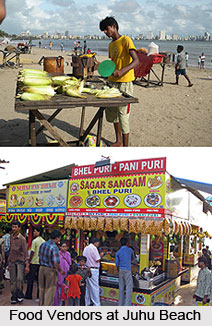 Juhu Beach is located 18 km north of the Mumbai city on the shores of Arabian Sea. This beach is very visited by many people round the year. Juhu Beach is spread across a stretch of 6 kms up to Versova Beach. Juhu Beach is a bourgeois paradise, filled to the gills with screaming children, families, courting couples and adolescents. It is situated in the central suburb of Mumbai, and offers cool breeze. The Juhu Beach in Mumbai is one of the most famous Indian Beaches. Juhu Beach borders a posh locality where most celebrities stay. Therefore, it is quite common to find famous celebrities jogging along the sands of Juhu beach. Tourists visit this beach because of its peaceful atmosphere and its scenic beauty. It is a popular tourist attraction and also a destination for shooting films. Hence, Juhu has come to be referred to as "The Beverly Hills of Bollywood". The ISKCON Temple in Juhu is very close from Juhu Beach.
Juhu Beach is located 18 km north of the Mumbai city on the shores of Arabian Sea. This beach is very visited by many people round the year. Juhu Beach is spread across a stretch of 6 kms up to Versova Beach. Juhu Beach is a bourgeois paradise, filled to the gills with screaming children, families, courting couples and adolescents. It is situated in the central suburb of Mumbai, and offers cool breeze. The Juhu Beach in Mumbai is one of the most famous Indian Beaches. Juhu Beach borders a posh locality where most celebrities stay. Therefore, it is quite common to find famous celebrities jogging along the sands of Juhu beach. Tourists visit this beach because of its peaceful atmosphere and its scenic beauty. It is a popular tourist attraction and also a destination for shooting films. Hence, Juhu has come to be referred to as "The Beverly Hills of Bollywood". The ISKCON Temple in Juhu is very close from Juhu Beach.
Juhu Beach is also famous for its local delicacies and street food. People in Mumbai visit this beach to relax and enjoy after a long, monotonous day. There are extravagant hotels and apartments located at the southern end of the beach. Watching the sunset in this wonderful place, guarded by the vast Arabian Sea, is a dream-like vision for anyone who visits the beach. Juhu Beach is not advisable for swimming and sun-bathing, but is a perfect place to enjoy the tasty local food and admire the mesmerizing sunsets.
Amusing Activities at Juhu Beach
The beautiful Juhu Beach, amidst the posh town of Mumbai, is a favourite hot-spot for many tourists. The beach generally gets more crowded on weekends. On weekends one can take the joy of acrobats, horse pulled carriages that offer joyrides; cricket matches, dancing monkeys, toy sellers and every other type of Indian beach entertainment. Vendors ply on the beach calling attention to their wares, which are mostly souvenirs like T-shirts and cute little Indian dolls made from seashells.
 The beach is among the most popular sites in the city for the annual Ganesh Chaturthi celebrations where thousands of devotees arrive in grand processions, carrying idols of the Lord Ganesh of various sizes, to be immersed in the water at the beach, and unfortunately, beach become very dirty.
The beach is among the most popular sites in the city for the annual Ganesh Chaturthi celebrations where thousands of devotees arrive in grand processions, carrying idols of the Lord Ganesh of various sizes, to be immersed in the water at the beach, and unfortunately, beach become very dirty.
Food at Juhu Beach
Generally it is not a very good place to swim, but it"s an ideal snack joint, with various food stalls. The food court at its main entrance is famous for its "Mumbai style" street food, notably Bhelpuri, Panipuri and Sevpuri. Juhu area is also home to many famous Seafood speciality restaurants, pizza joints, exclusive vegetarian restaurants, ice-cream parlours, south Indian restaurants, Italian speciality restaurant, etc. Juhu area also has many well known bars, pubs and discotheques.
Best Time to Visit Juhu Beach
The best time to visit Juhu Beach is from the months of October to February. It is best to avoid visiting the beach during the monsoon season as high tides are expected during this time.
How to Reach Juhu Beach
Juhu Beach is easily accessible by road. Apart from taxis and autos, private buses from many areas of the city are available. The beach is situated very close to the city airport. One can hire a taxi or auto from the airport to the beach. As Mumbai is well-connected by rail routes, Ville Parle station is the closest railway station to Juhu Beach at a distance of 3 km from the main spot.



















